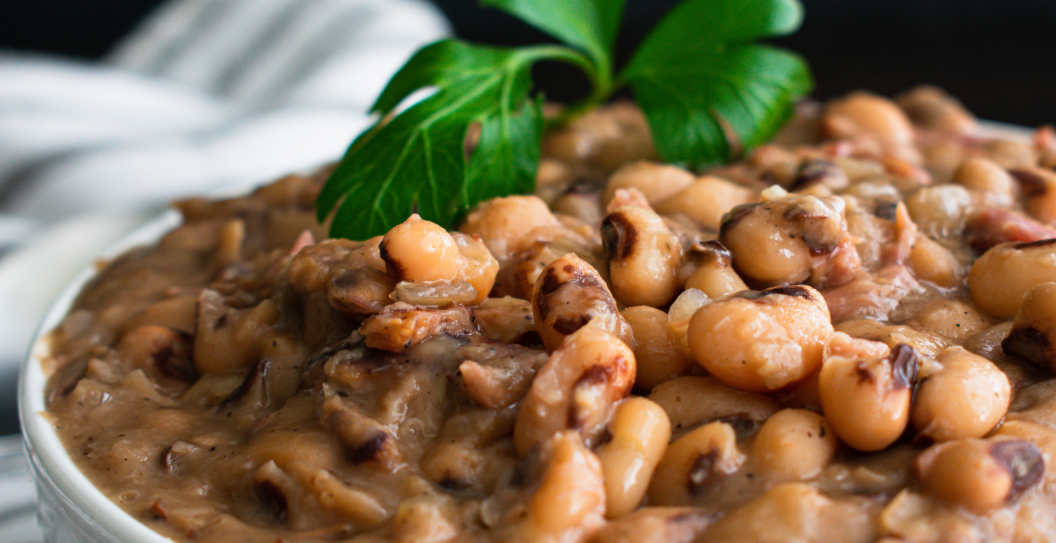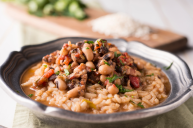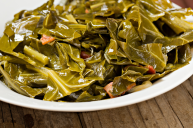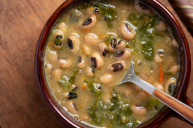It's New Year's Eve, and the clock is counting down: three, two, one — Happy New Year! After you've kissed everyone you can in the room to celebrate, what's next? Well, someone might just hand you a big bowl of black-eyed peas. If this happens, you'll want to be in the know about the tradition of eating black-eyed peas on New Year's Day.
Videos by Wide Open Country
Have you ever stopped to think about why black-eyed peas are a New Year's tradition? This practice is most popular in the southeastern U.S., where it's been a long-standing New Year's tradition since the Civil War. Eating black-eyed peas is all about bringing prosperity and good luck to the new year.
Like many beans and peas, black-eyed peas — also called "cowpeas" — qualify as a legume and are shaped like a kidney bean. Their most striking feature is the "black eye" along the inner curve. Black-eyed peas are known for their sweet, nutty flavor, so it's not difficult to enjoy them come New Year's Day.
Keep reading to find out more about this wholly American New Year's tradition. You'll also learn how to prepare black-eyed peas no matter what time of year it is, along with some top-notch recipes.
Why Do We Eat Black-Eyed Peas on New Year's Day?
Black-eyed peas originally came from West African food traditions and were also consumed by enslaved populations in the U.S. Though not considered a high-status food, black-eyed peas became a huge blessing when food was scarce during the Civil War.
Though likely a legend, black-eyed peas are associated with Union Gen. William T. Sherman's "March to the Sea." Among food supplies, pork and peas were not ransacked because they were considered undesirable.
Since then, Southerners have associated black-eyed peas with good luck. They also symbolize freedom for formerly enslaved African Americans, who were officially emancipated on New Year's Day in 1863.
Are Black-Eyed Peas Nutritious?
In the early 20th century, George Washington Carver promoted black-eyed peas as a healthy legume that added nitrogen to the soil. One cup of cooked black-eyed peas has 160 calories and roughly half a gram of fat. They're high in protein, fiber and complex carbohydrates (the good kind!). They're also known for promoting heart health and good digestion, plus they can sometimes aid in weight loss.
How Are Dried Black-Eyed Peas Prepared?
The first step in preparing dried black-eyed peas is sorting them. This means picking through them and taking out anything that's not a well-formed black-eyed pea. Once the peas are rinsed, place them in a large pot filled with 4 inches of water. It's best to let them soak overnight. If you're short on time, you can boil the peas for two minutes and then let them soak for an hour.
Once the black-eyed peas have soaked, give them another rinse and then simmer them in fresh water until they're tender. This should take about an hour, but make sure to test them to avoid mushy peas.
How Should You Season Black-Eyed Peas?
Some popular seasonings that help elevate the flavor of black-eyed peas include bay leaves, garlic powder, onion powder, paprika and cayenne. Chili powder, cilantro and oregano work just as well, depending on your recipe. Evoke New Orleans with a cajun seasoning that incorporates most black-eyed pea-friendly spices. Other options for adding flavor include cooking the black-eyed peas in broth, bouillon or stock instead of water.
What Should You Serve With Black-Eyed Peas?
Many Southern staples pair perfectly with black-eyed peas no matter the occasion. Pork, bacon and sweet potatoes can often be found sharing the plate, while collard greens are the most traditional. Greens symbolize the color of money to double down on the prosperity theme for New Year's.
Other unique sides include lemon asparagus, coleslaw and corn salad. Go old school with hearty comfort dishes such as cheesy grits, mac and cheese or skillet cornbread to round out this luckiest of meals. Cornbread and cheese grits represent gold, another nod to a new year filled with wealth.
What Are the Best Black-Eyed Pea Recipes?
If you're thinking about trying black-eyed peas this New Year's, have a look at some of the most popular Southern recipes. Tradition dictates that you eat black-eyed peas right after midnight or for the main meal on New Year's Day.
- Hoppin' John: Also called Carolina Peas and Rice, Hoppin' John is just as it's described. It consists of black-eyed peas and rice, mostly served with bacon or pork and onion. Here, the black-eyed peas represent pennies for monetary prosperity. Often, a penny or coin is dropped into the bottom of the pot or placed under guests' bowls.
- Texas Style: Texas-style black-eyed peas are more of a stew made with ham hock or bacon, onion, spices and a jalapeño. Serve with buttermilk cornbread for the most authentic combination.
- Salad with Black-Eyed Peas: For a different approach, a salad with black-eyed peas includes red onion, corn, tomato and scallion. Top with a spicy apple cider vinegar dressing for a lighter option this New Year's Day.
Tradition dictates you eat at least 365 black-eyed peas on New Year's Day to achieve a whole year of good luck. It's easy to do because they're nothing short of delicious when prepared right.




